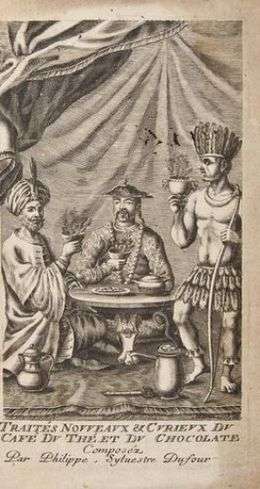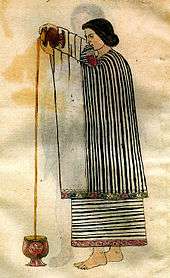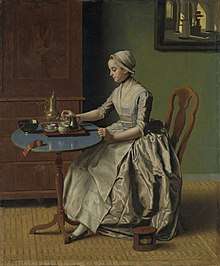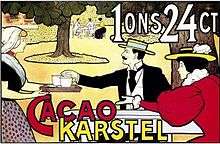History of chocolate
The history of chocolate began in Mesoamerica. Fermented beverages made from chocolate date back to 450 BC.[1] The Aztecs believed that cacao seeds were the gift of Quetzalcoatl, the god of wisdom, and the seeds once had so much value that they were used as a form of currency. Originally prepared only as a drink, chocolate was served as a bitter liquid, mixed with spices or corn puree. It was believed to be an aphrodisiac and to give the drinker strength. Today, such drinks are also known as "Chilate" and are made by locals in the South of Mexico. After its arrival to Europe in the sixteenth century, sugar was added to it and it became popular throughout society, first among the ruling classes and then among the common people. In the 20th century, chocolate was considered essential in the rations of United States soldiers during war.[2]

The word "chocolate" comes from the Classical Nahuatl word Xocolātl, and entered the English language from the Spanish language.[3]
History

Cultivation, consumption, and cultural use of cacao were extensive in Mesoamerica where the cacao tree is native.[4] When pollinated, the seed of the cacao tree eventually forms a kind of sheath, or ear, 20" long, hanging from the tree trunk itself. Within the sheath are 30 to 40 brownish-red almond-shaped beans embedded in a sweet viscous pulp. While the beans themselves are bitter due to the alkaloids within them, the sweet pulp may have been the first element consumed by humans.
Cacao pods grow in a wide range of colors, from pale yellow to bright green, all the way to dark purple or crimson. The skin can also vary greatly - some are sculpted with craters or warts, while others are completely smooth. This wide range in type of pods is unique to cacaos in that their color and texture does not necessarily determine the ripeness or taste of the beans inside.[5]
Evidence suggests that it may have been fermented and served as an alcoholic beverage as early as 1400 BC.[6]
Cultivation of the cacao was not an easy process. Part of this was because cacao trees in their natural environment grow to 60 feet tall or more. When the trees were grown in a plantation; however, they grew to around 20 feet tall.
While researchers do not agree on which Mesoamerican culture first domesticated the cacao tree, the use of the fermented bean in a drink seems to have arisen in North America (Mesoamerica—Central America and Mexico). Scientists have been able to confirm its presence in vessels around the world by evaluating the "chemical footprint" detectable in the micro samples of contents that remain.[1] Ceramic vessel with residues from the preparation of chocolate beverages have been found at archaeological sites dating back to the Early Formative (1900–900 BC) period. For example, one such vessel found at an Olmec archaeological site on the Gulf Coast of Veracruz, Mexico dates chocolate's preparation by pre-Olmec peoples as early as 1750 BC.[7] On the Pacific coast of Chiapas, Mexico, a Mokayanan archaeological site provides evidence of cacao beverages dating even earlier, to 1900 BC.[7]
Pueblo people, who lived in an area that is now the U.S. Southwest, imported cacao from Mesoamerican cultures in southern Mexico between 900 and 1400. They used it in a common beverage consumed by everyone in their society.[1]
Archaeological evidence of Cacao in Mesoamerica
Nature Ecology & Evolution reported probably the earliest cacao use from approximately 5,300 years ago recovered from the Santa Ana (La Florida) site in southeast Ecuador.[8] Another find of chemically traced cacao was in 1984 when a team of archaeologists in Guatemala explored the Mayan site of Río Azul. They discovered fifteen vessels surrounding male skeletons in the royal tomb. One of these vessels was beautifully decorated and covered in various Mayan glyphs. One of these glyphs translated to "kakaw", also known as cacao. The inside of the vessel was lined with a dark-colored powder, which was scraped off for further testing. Once the archaeologists took this powder to the Hershey Center for Health and Nutrition to be tested, they found trace amounts of theobromine in the powder, a major indicator of cacao. This cacao was dated to sometime between 460 and 480 AD [9]
Cacao powder was also found in beautifully decorated bowls and jars, known as tecomates, in the city of Puerto Escondido. Once thought to have been a very rare commodity, cacao was found in many more tecomates than once thought possible. However, since this powder was only found in bowls of higher quality, it led archaeologists to believe that only wealthier people could afford such bowls, and therefore the cacao. The cacao tecomates are thought to have been a centerpiece to social gatherings between people of high social status.[9]
Olmec use
Earliest evidence of domestication of the cacao plant dates to the Olmec culture from the Preclassic period.[10] The Olmecs used it for religious rituals or as a medicinal drink, with no recipes for personal use. Little evidence remains of how the beverage was processed.
Mayan use
The Mayans, (in Guatemala), by contrast, do leave some surviving writings about cacao which confirm the identification of the drink with the gods. The Dresden Codex specifies that it is the food of the rain deity Kon, the Madrid Codex that gods shed their blood on the cacao pods as part of its production.[11] The Maya people gathered once a year to give thanks to the god Ek Chuah who they saw as the Cacao god.[12] The consumption of the chocolate drink is also depicted on pre-Hispanic vases. The Maya seasoned their chocolate by mixing the roasted cacao seed paste into a drink with water, chile peppers and cornmeal, transferring the mixture repeatedly between pots until the top was covered with a thick foam.[2]
There were many uses for cacao among the Maya. It was used in official ceremonies and religious rituals, at feasts and festivals, as funerary offerings, as tribute, and for medicinal purposes. Both cacao itself and vessels and instruments used for the preparation and serving of cacao were used for important gifts and tribute.[13] Cacao beans were used as currency, to buy anything from avocados to turkeys to sex. A rabbit, for example, was worth ten cacao beans, (called “almonds” by the early sixteenth-century chronicler Francisco Oviedo y Valdés), a slave about a hundred, and the services of a prostitute, eight to ten “according to how they agree,”.[14] The beans were also used in betrothal and marriage ceremonies among the Maya, especially among the upper classes.
“The form of the marriage is: the bride gives the bridegroom a small stool painted in colors, and also gives him five grains of cacao, and says to him “These I give thee as a sign that I accept thee as my husband.” And he also gives her some new skirts and another five grains of cacao, saying the same thing.”[15]
Maya preparation of cacao started with cutting open cacao pods to expose the beans and the fleshy pulp. The beans were left out to ferment for a few days. In some cases, the beans were also roasted over an open fire in order to add a smoky flavor to it. The beans then had their husks removed and were ground into a paste. Since sweeteners were rarely used by Maya, they flavored their cacao paste with additives like flowers, vanilla pods, and chilies. The vessel used to serve this chocolate liquid was stubbier by nature to help froth the liquid better, which was very important to the Maya. The vessels also tended to be decorated in intricate designs and patterns, which tended to only be accessible by the rich.[16]
Aztec use
By 1400, the Aztec Empire took over a sizable part of Mesoamerica. They were not able to grow cacao themselves, but were forced to import it.[2] All of the areas that were conquered by the Aztecs that grew cacao beans were ordered to pay them as a tax, or as the Aztecs called it, a "tribute". The cacao bean became a form of currency. The Spanish conquistadors left records of the value of the cacao bean, noting for instance that 100 beans could purchase a canoe filled with freshwater or a turkey hen.[6][17] The Aztecs associated cacao with the god Quetzacoatl, whom they believed had been condemned by the other gods for sharing chocolate with humans.[2] Unlike the Maya of Yucatán, the Aztecs drank chocolate cold. It was consumed for a variety of purposes, as an aphrodisiac or as a treat for men after banquets, and it was also included in the rations of Aztec soldiers.[18]
History in Europe
Early history
Until the 16th century, the cacao tree was wholly unknown to Europeans.[2]
Christopher Columbus encountered the cacao bean on his fourth mission to the Americas on August 15, 1502, when he and his crew seized a large native canoe that proved to contain among other goods for trade, cacao beans.[19] His son Ferdinand commented that the natives greatly valued the beans, which he termed almonds, "for when they were brought on board ship together with their goods, I observed that when any of these almonds fell, they all stooped to pick it up, as if an eye had fallen."[19] But while Columbus took cacao beans with him back to Spain,[19] it made no impact until Spanish friars introduced chocolate to the Spanish court.[2]

Spanish conquistador Hernán Cortés may have been the first European to encounter chocolate when he observed it in the court of Montezuma in 1519.[20] In 1568, Bernal Díaz, who accompanied Cortés in the conquest of Mexico, wrote of this encounter which he witnessed:
From time to time they served him [Montezuma] in cups of pure gold a certain drink made from cacao. It was said that it gave one power over women, but this I never saw. I did see them bring in more than fifty large pitchers of cacao with froth in it, and he drank some of it, the women serving with great reverence.[21]
José de Acosta, a Spanish Jesuit missionary who lived in Peru and then Mexico in the later 16th century, described its use more generally:
Loathsome to such as are not acquainted with it, having a scum or froth that is very unpleasant taste. Yet it is a drink very much esteemed among the Indians, wherewith they feast noble men who pass through their country. The Spaniards, both men and women that are accustomed to the country are very greedy of this chocolate. They say they make diverse sorts of it, some hot, some cold, and some temperate, and put therein much of that "chili"; yea, they make paste thereof, the which they say is good for the stomach and against the catarrh.
After the Spanish conquest of the Aztecs, chocolate was imported to Europe. In the beginning, Spaniards would use it as a medicine to treat illnesses such as abdominal pain because it had a bitterness to it. Once sweetened, it transformed.[22] It quickly became a court favorite. It was still served as a beverage, but the addition of sugar or honey counteracted the natural bitterness.[6] The Spaniards initially intended to recreate the original taste of the Mesoamerican chocolate by adding similar spices, but this habit had faded away by the end of the eighteenth century.[23] Within about a hundred years, chocolate established a foothold throughout Europe.[2]
According to the authority on the Spanish language, the Royal Spanish Academy, the Spanish word "chocolate" is derived from the Nahuatl word "xocolatl" (pronounced Nahuatl pronunciation: [ ʃoˈkolaːtɬ]), which is made up from the words "xococ" meaning sour or bitter, and "atl" meaning water or drink.[24] However, as William Bright noted[25] the word "chocolatl" doesn't occur in central Mexican colonial sources making this an unlikely derivation. Santamaria[26] gives a derivation from the Yucatec Maya word "chokol" meaning hot, and the Nahuatl "atl" meaning water. More recently Dakin and Wichman derive it from another Nahuatl term, "chicolatl" from Eastern Nahuatl meaning "beaten drink".[27] They derive this term from the word for the frothing stick, "chicoli". The word xocoatl means beverage of the maize.[28] The words "cacaua atl" mean drink of cacao.[28] The word "xocolatl" does not appear in Molina's dictionary, Vocabulario en Lengua Castellana y Mexicana y Mexicana y Castellana.[28]
Expansion

The new craze for chocolate brought with it a thriving slave market, as between the early 17th and late 19th centuries the laborious and slow processing of the cacao bean was manual.[2] Cacao plantations spread, as the English, Dutch, and French colonized and planted. With the depletion of Mesoamerican workers, largely to disease, cocoa beans production was often the work of poor wage laborers and African slaves.
1729 - The first mechanic cocoa grinder was invented in Bristol, UK. Walter Churchman petitions king of England for patent and sole use of an invention for the “expeditious, fine and clean making of chocolate by an engine.” The patent was granted by His Majesty King George II to Walter Churchman for a water engine used to make chocolate. Churchman probably used water-powered edge runners for preparing cacao beans by crushing on a far larger scale than previously [29]. The patent for a chocolate refining process was later bought by J. S. Fry & Sons in 1761. [30]
Wind-powered and horse-drawn mills were used to speed production, augmenting human labor. Heating the working areas of the table-mill, an innovation that emerged in France in 1732, also assisted in extraction.[31] The Chocolaterie Lombart, created in 1760, claimed to be the first chocolate company in France, ten years before Pelletier et Pelletier.[32]
New processes that speed the production of chocolate emerged early in the Industrial Revolution. In 1815, Dutch chemist Coenraad van Houten introduced alkaline salts to chocolate, which reduced its bitterness.[2] A few years thereafter, in 1828, he created a press to remove about half the natural fat (cacao butter) from chocolate liquor, which made chocolate both cheaper to produce and more consistent in quality. This innovation introduced the modern era of chocolate.[19] Known as "Dutch cocoa", this machine-pressed chocolate was instrumental in the transformation of chocolate to its solid form when in 1847 Joseph Fry learned to make chocolate moldable by adding back melted cacao butter.[6] Milk had sometimes been used as an addition to chocolate beverages since the mid-17th century, but in 1875 Daniel Peter invented milk chocolate by mixing a powdered milk developed by Henri Nestlé with the liquor.[2][19] In 1879, the texture and taste of chocolate was further improved when Rodolphe Lindt invented the conching machine.[33]
Lindt & Sprüngli AG, a Swiss-based concern with global reach, had its start in 1845 as the Sprüngli family confectionery shop in Zurich that added a solid-chocolate factory the same year the process for making solid chocolate was developed and later bought Lindt's factory. Besides Nestlé, several chocolate companies had their start in the late 19th and early 20th centuries. Cadbury was manufacturing boxed chocolates in England by 1868.[2] In 1893, Milton S. Hershey purchased chocolate processing equipment at the World's Columbian Exposition in Chicago and soon began the career of Hershey's chocolates with chocolate-coated caramels.
Due to improvements in machines, chocolate underwent a transformation from a primarily a drink to food, and different types of chocolate began to emerge. At the same time, the price of chocolate began to drop dramatically in the 1890s and 1900s as the production of chocolate began to shift away from the New World to Asia and Africa. Therefore, chocolate could be purchased by the middle class.[34] Due to the lower cost of chocolate, it happened a problem that forced child labor. In 1900–1907, Cadbury's fell into a scandal due to their reliance on West African slave plantations.[35]
Although it was men leading the charge towards mass production of chocolate for everyday people, advertisements also targeted women, who “were charged with providing wholesome cocoa for respectable consumption within the family,”.[36] Women were also targeted by advertising campaigns within courtship rituals,[36] though most early advertising was aimed more at housewives and mothers than at single women.
Modern use
Roughly two-thirds of the world's cocoa is produced in Western Africa, with Ivory Coast being the largest source, producing a total crop of 1,448,992 tonnes.[37] Ghana, Nigeria, and Cameroon are other West African countries among the top 5 cocoa-producing countries in the world. Like many food industry producers, individual cocoa farmers are at the mercy of volatile world markets. The price can vary from between £500 ($945) and £3,000 ($5,672) per ton in the space of just a few years. While investors trading in cocoa can dump shares at will, individual cocoa farmers can not ramp up production and abandon trees at anywhere near that pace.
Only three to four percent of "cocoa futures" contracts traded in the cocoa markets ever end up in the physical delivery of cocoa. Every year seven to nine times more cocoa is bought and sold on the exchange than exists.
See also
- Alonso de Molina's dictionary of 1571 and of 1555
- Food history
- History of yerba mate
Further reading
- Mara P. Squicciarini and Johan Swinnen. 2016. The Economics of Chocolate. Oxford University Press.
References
- Watson, Traci (22 January 2013). "Earliest Evidence of Chocolate in North America". Science. Retrieved 3 March 2014.
- Kerr, Justin (2007). "History of Chocolate". Field Museum. Retrieved 2014-03-03.
- "The American Heritage Dictionary". Archived from the original on October 11, 2008. Retrieved 2009-05-09.
- Kiple, Kenneth F.; Kriemhild Coneè Oyurnelas (2000). The Cambridge world history of food. Cambridge University Press. pp. 635–638. ISBN 978-0-521-40214-9.
- Schnepel, Ellen (Fall 2002). "Chocolate: From Bean to Bar". Gastronomica. 2 (4): 98–100. doi:10.1525/gfc.2002.2.4.98.
- Bensen, Amanda (March 1, 2008). "A Brief History of Chocolate". Smithsonian Magazine. Retrieved 3 March 2014.
- Terry G. Powis; W. Jeffrey Hurst; María del Carmen Rodríguez; Ponciano Ortíz C.; Michael Blake; David Cheetham; Michael D. Coe; John G. Hodgson (December 2007). "Oldest chocolate in the New World". Antiquity. 81 (314). ISSN 0003-598X. Retrieved 2011-02-15.
- Sonia, Zarillo (October 2018). "The use and domestication of Theobroma cacao during the mid-Holocene in the upper Amazon". Nature Ecology & Evolution.
- Edgar, Blake (November 2010). "The Power of Chocolate". Archaeology. 63 (6): 20–25.
- Coe, Sophie Dobzhansky; Coe, Michael D. (2007). The True History of Chocolate. Thames and Hudson. ISBN 978-0-500-28696-8.
- Thompson, J. Eric S. (1956). "Notes on the use of cacao in Middle America". Middle American Archaeology. Cambridge Mass. 128: 95–116.
- "Medicinal and Ritualistic Uses for Chocolate in Mesoamerica - HeritageDaily - Heritage & Archaeology News". www.heritagedaily.com. Retrieved 2018-05-07.
- Presilla, Maricel E. (2009). The New Taste of Chocolate, Revised: A Cultural and Natural History of Cacao with Recipes. New York: Ten Speed Press. pp. 12, 16, 22.
- Coe, Sophie D.; Coe, Michael D. (1996). The True History of Chocolate. London: Thames & Hudson Ltd. p. 59.
- Coe, Sophie D.; Coe, Michael D. (2007). The True History of Chocolate. London: Thames & Hudson Ltd. p. 61.
- Keoke, Emory Dean; Porterfield, Kay Marie (1 January 2009). Encyclopedia of American Indian Contributions to the World: 15,000 Years of Inventions and Innovations. Infobase Publishing. p. 43. ISBN 978-1-4381-0990-9.
- Szogyi, Alex (1 January 1997). Chocolate: Food of the Gods. Greenwood Publishing Group. pp. 149–151. ISBN 978-0-313-30506-1.
- Spadaccini, Jim. "The Sweet Lure of Chocolate". Exploratorium. Retrieved 2014-03-03.
- Burleigh, Robert (2002). Chocolate: Riches from the Rainforest. Harry N. Abrams, Ins., Publishers. ISBN 978-0-8109-5734-3.
- The Bernal Diaz Chronicles, translated and edited by Albert Idell, published by Doubleday Dolphin, 1956, p.160
- TED-Ed (2017-03-16), The history of chocolate - Deanna Pucciarelli, retrieved 2018-05-07
- Norton, Marcy (April 2004). "Conquests of Chocolate". OAH Magazine of History. 18 (3): 16. JSTOR 25163677.
- "Diccionario de la lengua española, Real Academia Española". rae.es.
- Campbell, Lyle. Quichean Linguistic Prehistory; University of California Publications in Linguistics No. 81. Berkeley, California: University of California Press. p. 104.
- Santamaria, Francisco. Diccionario de Mejicanismos. Mexico: Editorial Porrúa S. A. pp. 412–413.
- Dakin, Karen; Wichmann, Soren (2000). "Cacao and Chocolate A Uto-Aztecan perspective". Ancient Mesoamerica. Cambridge: Cambridge University Press. 11 (1): 55–75. doi:10.1017/S0956536100111058.
- Molina, Fray Alonso de (1977). Vocabulario en Lengua Castellana y Mexicana y Mexicana y Castellana. Edicion Facsimile. Mexico: Editorial Porrua, S.A. p. 10.
- "Appendix 8: Chocolate Timeline", Chocolate, John Wiley & Sons, Ltd, pp. 855–928, 2008, doi:10.1002/9780470411315.app8, ISBN 978-0-470-41131-5, retrieved 2020-07-15
- "J. S. Fry & Sons", Wikipedia, 2020-06-20, retrieved 2020-07-15
- Wilson & Hurst, "Chocolate and Health: Chemistry, Nutrition and Therapy", p. 219, Royal Society of Chemistry, 2015
- Clarence-Smith, William Gervase (2003-09-02), Cocoa and Chocolate, 1765-1914, Routledge, p. 48, ISBN 978-1-134-60778-5, retrieved 2017-09-12
- Klein, Christopher (February 14, 2014). "The Sweet History of Chocolate". History. Retrieved 2014-03-03.
- Clarence-Smith, William Gervase (2000). Cocoa and chocolate, 1765-1914. London, New York: Routledge.
- North, Rodney (2008). "CHILD LABOR IN THE COCOA INDUSTRY". Equal Exchange.
- Robertson, Emma (2009). Chocolate, women and empire: A Social and Cultural History. Manchester: Manchester University Press. p. 20.
- "Top 10 Cocoa Producing Countries". WorldAtlas. Retrieved 2017-10-09.
